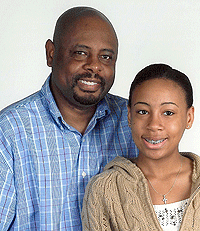It’s no accident that Brian K. Phillips is an urban planner. Having lived in one of the most infamous urban planning disasters in U.S. history, he understands firsthand that successful redevelopment of city neighborhoods must include a careful balance of quality architectural design, green space, and economic and racial diversity.
As executive director of the Washington University Medical Center (WUMC), he’s working to bring all these factors to bear on the redevelopment of the Forest Park Southeast neighborhood at the School of Medicine’s doorstep.

Phillips spent his early childhood in St. Louis’ Pruitt-Igoe public housing project, the massive concrete city that concentrated at its peak more than 12,000 residents — overwhelmingly African-American and poor — in 33 high-rise apartment towers.
The youngest of six children, he was 4 when his parents moved their family out in the early 1970s. But Phillips still remembers the dark hallways, the broken elevators and the overpowering smell of urine in the buildings’ public areas.
“We moved because my mother was adamant about making sure that wherever we lived, her kids would have the right opportunities,” Phillips says. “Pruitt-Igoe began as one of the greatest social experiments in urban planning, but it quickly became a nightmare.”
The ultra-modern design was intended to keep city residents from fleeing to the suburbs, but cost overruns prevented the addition of planned playgrounds and landscaping. Poor construction and cheap materials led to the buildings’ deterioration, which quickly gave way to crime and drug dealing.
And Phillips’ own family was not immune from the violence. His mother was robbed at gunpoint in one of the complex’s elevators as she held Brian, then an infant, in her arms (the gun was actually pointed at him).
“She always tells me I cost her her last $10,” he now jokes.
But today, in an office just a few miles from the former site of Pruitt-Igoe, Phillips is overseeing an urban success story in the making.
The WUMC, a partnership between the medical school and BJC HealthCare, has pumped more than $20 million into Forest Park Southeast, and the investment is paying off.

To date, more than 200 apartments and homes in the neighborhood have been renovated, and new restaurants and shops have opened, many along the Manchester Avenue business district.
The driving force behind the neighborhood’s revitalization is WUMC’s ongoing investment.
“The effect of the investment has been amazing,” Phillips says. “We continually get calls from people around the country asking us how we’re doing it and what initiatives we’re undertaking.”
The neighborhood lies south and east of the Washington University Medical Center and is bounded by Interstate 44 to the south, Kingshighway Boulevard to the west, Interstate 64/Highway 40 to the north and Vandeventer Avenue to the east.
A little more than a decade ago, gangs, drug-dealers and gun violence overran Forest Park Southeast. Much of the century-old housing had been neglected or abandoned.
Phillips has played a key role in the neighborhood’s transformation by building consensus among neighborhood groups and the medical center and working with developers to make sure that projects move forward.
“Brian has certainly proven himself to be the right person to lead the redevelopment program in the Forest Park Southeast neighborhood,” said Richard A. Roloff, vice chancellor for capital projects and a board member of WUMC. “The challenges he faces vary dramatically from day to day, but Brian adapts well to new situations. He deserves a great deal of credit for the successful emergence of the neighborhood that we have witnessed.”
The University and BJC have a vested interest in ensuring that neighborhoods surrounding the medical center are stable.
“I look at the Forest Park Southeast neighborhood as the institutions’ front door and the Central West End as their flank,” Phillips says. “We have a responsibility to make sure the neighborhoods are stable and safe. Our goal is to bring Forest Park Southeast to the level where private investment is attractive, and that is happening now. The transformation on Manchester is all happening with private investment.”
The WUMC has been involved in redeveloping the Central West End to stabilize that neighborhood since it was established in the 1970s. But the Forest Park Southeast’s turnaround began in 1996 when the University was awarded a five-year, $2.5 million grant from the U.S. Department of Housing and Urban Development (HUD), part of an experimental program to assist neighborhood revitalization efforts.
The University was one of only five nationwide that received the federal funds, which traditionally had gone to cities and counties. WUSTL pooled its resources with BJC, the City of St. Louis and private investors to add an additional $9 million in initial investment to Forest Park Southeast.
Virtually overnight, the University needed someone who understood HUD to oversee the grant’s disbursement, with all of its bureaucratic requirements and stipulations.
|
Brian K. Phillips Title: Executive director of Washing-ton University Medical Center Education: Bachelor’s degree in community and regional planning, Iowa State University Born: St. Louis Family: Daughter, Chanel, 14 Hobbies and interests: An avid reader, he just finished “The Senator and the Socialite: The True Story of American’s First Black Dynasty” by Lawrence Otis Graham; loves to pore over maps; a gadget guru who owns an iPod, he enjoys building his music collection, now 4,200 songs strong — a mix of jazz, R&B, hip hop and gospel; and as an “ambassador” for his alma mater, he interviews and recruits local students to attend Iowa State |
Phillips had just the experience the University was looking for. He graduated from Iowa State University with a bachelor’s degree in community and regional planning and worked for the City of St. Louis both as a city planner and a community development specialist and monitored numerous projects funded by HUD.
Phillips initially came to WUMC as a community program specialist and helped develop a plan to revitalize Forest Park Southeast. The early focus was on stabilizing the neighborhood and subsidizing housing development.
For example, in the northern section of the neighborhood, two-family homes were gutted and converted into single-family residences. The houses were valued at about $150,000, but with the subsidy, they could be sold for $89,000 to low- and moderate-income families.
Phillips also assisted the Regional Housing and Community Development Alliance in buying out the largest absentee landlord in northern Forest Park Southeast. The landlord’s 115 buildings were rehabbed into 73 affordable apartments and 11 homes for sale.
“Our initial focus on low- and moderate-income housing has been important,” Phillips says, “because with new development comes the real possibility of residents being priced out of the market. We wanted to keep the diversity in the neighborhood and stabilize low-income housing.”
Now, in this area of the neighborhood, subsidies are no longer needed to lure homebuyers, and three-bedroom homes are selling for $225,000.
In another development project slated to begin later this year, new homes will go on the market at $275,000. This revitalization is attracting new residents, including employees of the University and nearby hospitals, city employees, professionals and young families.
WUMC’s projects in Forest Park Southeast have not been limited to housing.
Early in the planning process, neighborhood residents made a plea to Phillips to help them reopen the neighborhood elementary school and build a community center.
Adams Elementary was closed in the early 1990s when the city’s school district was still under court-ordered desegregation. The neighborhood was integrated, but the district needed children in Forest Park Southeast to integrate other schools. Kids from the neighborhood were being bused to 29 public elementary schools in the city and 10 school districts in St. Louis County.
“We thought the key to revitalizing and stabilizing the neighborhood was to reopen that school,” Phillips says. “We brokered a deal with the school district to reopen Adams Elementary, and in exchange, we built an adjoining community center and city park that includes baseball fields.”
Phillips is praised for his abilities to bring together people with diverse ideas and get them to work toward a common goal.
“Brian is a total asset to this neighborhood,” said Saundra Moss, a member of the Forest Park Southeast Neighborhood Association. “He is more than willing to work with any and all of us. If it hadn’t been for Brian, we wouldn’t have been able to accomplish very much.”
While some may have thrown up their arms in frustration, Phillips drew on communication and team-building skills learned at Iowa State. As an African-American in a predominately white university with a growing number of international and minority students, Phillips learned how to affect change by working through the system, even when the system was not used to change.
“I learned that to build community in a place, you have to include everyone, not just the majority group, right from the beginning,” he says.
Phillips was just shy of completing his graduate degree when he became a father and moved back to his native St. Louis to work for the city to support his family.
His daughter, Chanel, is now 14 and lives with her mother in Des Moines, Iowa, but he enjoys her many visits to St. Louis.
When he entered college, Phillips had planned to be an architect, but today, he has no regrets about his career choice.
“Urban planners get to make so many huge decisions for so many folks,” he says. “Architects build houses, but urban planners build neighborhoods.”